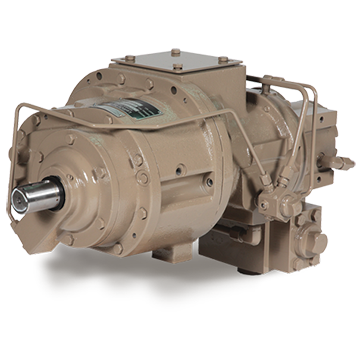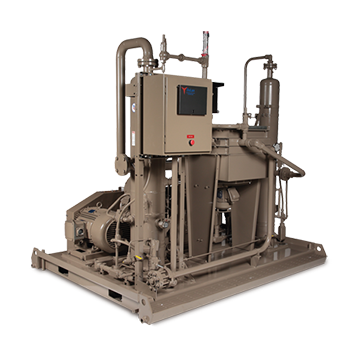Choose a different country or region to see the content specific to your location
 Global (EN)
Global (EN)
Choose a different country or region to see the content specific to your location
 Global (EN)
Global (EN)
Renewable Natural Gas (RNG), also called biomethane, is an upgraded biogas that can be used in many different applications to help reduce greenhouse gas emissions and improve sustainability efforts. RNG is produced by removing moisture, carbon dioxide, and trace levels of other contaminants from biogas. This renewable fuel source can be either used locally at the site or injected into natural gas transmission or pipeline to be used at another location. Options for use range from thermal applications to electricity to vehicle fuel.
LeROI natural gas compressors play a critical role in RNG processes in agricultural production facilities (livestock and dairy), landfill and water treatment industries.
1. Biogas Collection: The biogas generated from waste or other organic sources is collected using a system of storage tanks, pipes and wells. The biogas typically contains impurities such as water vapor, hydrogen sulfide (H2S), and siloxanes.
2. Primary treatment: Before the biogas can be compressed, it undergoes a pre-treatment to remove impurities. Water vapor is removed through condensation, and H2S is often removed using desulfurization processes. Siloxanes, which can damage the compressor, are typically removed through activated carbon filters. However, LeROI compressors allow you to skip primary treatment steps before moving to compression. Our natural gas compressors can handle “nasty gases” without the need for additional equipment.
3. Compression: The purified biogas, now mostly consisting of methane, is compressed using a natural gas air compressor. These compressors operate similarly to standard air compressors but are designed specifically for the harsh conditions natural gas compression requires. The compressor increases the pressure of the biogas, typically to several hundred pounds per square inch (psi).
4. Cooling and Drying: After compression, the biogas may pass through a cooling system to reduce its temperature. This helps condense any remaining water vapor, which is then removed. Drying the gas is important to prevent corrosion and ensure the proper functioning of downstream equipment.
5. Storage and Distribution: The compressed and dried biogas, now known as RNG, is stored in high-pressure tanks or transported through pipelines for various uses.
Livestock methane contributes to about 14% of all greenhouse gas emissions. From dairy farms to livestock production, agricultural facilities have the opportunity to steer animal waste and harmful greenhouse gases away from the environment and turn it into a renewable source of energy. Gas is captured in anaerobic digesters as solids and liquids begin to break down. Impurities and gases, such as carbon dioxide, hydrogen sulfide and moisture, are removed.
LeROI biogas and biomethane compressors safely collect and compress this low pressure gas mixture. This biogas is then upgraded to increase its methane content so it is similar to a convention natural gas, and RNG is produced.
Similar to agricultural applications, gases are captured from landfills as solid organic matter decomposes. The gas is captured in landfill applications using wells and pipes as opposed to digesters. Landfill gas (LFG) is comprised of about 50% methane, 50% carbon dioxide and some other organic compounds. This gas is funneled to a biogas compressor as the first step in converting landfill gas into electric energy. LFG is upgraded and purified to become RNG by removing moisture, contaminants and other gases while ensuring a higher concentration of methane.
Because RNG is a replacement for traditional gasoline, it significantly reduces the amount of nitrogen oxides and harmful particulate matter released into the air. RNG production can reduce greenhouse gas emissions, primarily methane, significantly. By capturing and converting these gases into renewable energy sources, RNG processes help reduce local smog, reduces odors and create an overall better
Not only does converting biogas into RNG help you reduce your carbon footprint, it is also an opportunity to earn Renewable Energy Credits from the Environmental Protection Agency (EPA). The EPA offers Renewable Energy Credits to organizations who modify their processes to generate renewable energy and reduce greenhouse gas emissions. This includes livestock operations and landfills. LeROI biogas compressors offer safe and reliable solutions that comply with EPA regulations for renewable energy credits.
Complementary to the LeROI natural gas compressors, Gardner Denver offers everything you need for instrument air needs to keep your RNG processes running smoothly.
Not only does Gardner Denver offer you reliable and robust compressed air equipment, but our extensive network of authorized Gardner Denver distributors ensures superior service support. These local authorized distributors can showcase the value of using genuine OEM parts and talk to you about the extended warranty programs we have that meet your needs. Whether it’s our Platinum 10-year extended airend warranty or our 5-year bumper to bumper Platinum+ program, we’ve got you covered.
About LeRoi
LeROI is a leading manufacturer of compressed gas systems providing solutions in a wide range of Oil & Gas, Industrial, and Process applications.
Our gas compressors are specifically designed to meet the needs of the gas industry. With innovative reciprocating and rotary technology, our products perform at the highest efficiency in the toughest conditions. Experienced in the gas industry for more than 25 years, LeROI has built a strong reputation as one of the major suppliers.

